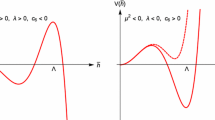Abstract
A recently popular formulation of the Higgs naturalness principle prohibits delicate cancellations between running renormalized Higgs mass parameters and EFT matching corrections, by contrast with the principle’s original formulation, which prohibits delicate cancellations between the bare Higgs mass parameter and its quantum corrections. While the need for this latter cancellation is sometimes viewed as unproblematic since bare parameters are thought by some to be divergent and unphysical, renormalized parameters are finite and measurable, and the need for delicate cancellations between the renormalized Higgs mass parameter and EFT matching corrections is therefore considered by some to constitute a more salient formulation of the Higgs naturalness problem. Here, we argue that to the contrary, the need for fine tuning of the renormalized Higgs mass parameter is an eliminable, unphysical artifact of renormalization scheme, and that this severely weakens the grounds for regarding it as a problematic instance of fine tuning. In doing so, we highlight what we take to be a number of important conceptual lessons about the physical interpretation of model parameters in QFT.
Similar content being viewed by others
Notes
At leading non-trivial order perturbation theory, one can take \(y_{t0}\) to be either a bare coupling or a renormalized coupling, since the corresponding expressions only differ at higher orders in perturbation theory.
See, for example, Martin [4] for a formulation of the Higgs naturalness problem along these lines.
On some usages of the term “renormalization scheme,” different renormalization schemes are associated with different choices of renormalization scale \(\mu \), and the difference between on-shell, minimal subtraction, off-shell momentum subtraction, etc. is a difference between different families of renormalization scheme. On the usage we adopt here, on-shell, minimal subtraction, off-shell momentum subtraction etc. are themselves referred to as different renormalization schemes; variation of the parameter \(\mu \) within such a scheme does not constitute a change of renormalization scheme, but only a change of renormalization scale.
Note that, in order to measure anything about the system, it needs to couple to something else. For example, the oscillating mass(es) could carry electric charge, which lets us access the frequency \(\omega \) of the system by the electromagnetic radiation it emits.
This line of argument is further developed in (see [6]).
See Rosaler and Harlander [6] for a more detailed defense of this claim.
The detailed form of the heavy field is not important to the argument here, and the same general points—which rest on the presence of matching corrections to the light scalar mass term that are quadratic in the mass of the heavy field—can be illustrated in a model where the heavy field is a scalar rather than a fermion field.
Indeed, the need for running, scale-dependent mass parameters at all is an artifact of renormalization scheme, since one can in principle always take the pole mass, whose value remains fixed and does not run, as the renormalized mass parameter.
References
Barbieri, R.: Electroweak theory after the first LHC phase. (2013). arXiv:1309.3473
Bianchi, E., Rovelli, C.: Why all these prejudices against a constant? (2010). arXiv:1002.3966
Craig, N.: Naturalness and new approaches to the hierarchy problem. Prospect. Theor. Phys. (2017)
Martin, S.P.: A supersymmetry primer. In: Perspectives on supersymmetry II, pp. 1–153. World Scientific (2010)
Morris, T.R.: Elements of the continuous renormalization group. Prog. Theor. Phys. Suppl. 131, 395–414 (1998)
Rosaler, J., Harlander, R.: Naturalness, Wilsonian renormalization, and “fundamental parameters” in quantum field theory. Unpublished manuscript (2018)
Schwartz, M.D.: Quantum field theory and the standard model. Cambridge University Press, Cambridge (2014)
Skiba, W.: Tasi lectures on effective field theory and precision electroweak measurements. (2010). arXiv:1006.2142
Susskind, L.: Dynamics of spontaneous symmetry breaking in the Weinberg–Salam theory. Phys. Rev. D 20(10), 2619 (1979)
Wetterich, C.: Fine-tuning problem and the renormalization group. Phys. Lett. B 140(3–4), 215–222 (1984)
Williams, Porter: Naturalness, the autonomy of scales, and the 125 GeV Higgs. Studies in History and Philosophy of Science Part B: Studies in History and Philosophy of Modern Physics 51, 82–96 (2015)
Acknowledgements
The authors gratefully acknowledge support from the DFG. This work was done within the DFG Research Unit “The Epistemology of the Large Hadron Collider” (Grant FOR 2063). We would like to thank all its members for comments and encouragement.
Author information
Authors and Affiliations
Corresponding author
Additional information
Publisher's Note
Springer Nature remains neutral with regard to jurisdictional claims in published maps and institutional affiliations.
Rights and permissions
About this article
Cite this article
Harlander, R., Rosaler, J. Higgs Naturalness and Renormalized Parameters. Found Phys 49, 879–897 (2019). https://doi.org/10.1007/s10701-019-00296-6
Received:
Accepted:
Published:
Issue Date:
DOI: https://doi.org/10.1007/s10701-019-00296-6



